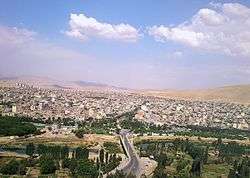Bukan
| Bukan بۆکان | |
|---|---|
| city | |
|
Bukan | |
 Bukan | |
| Coordinates: 36°31′16″N 46°12′32″E / 36.52111°N 46.20889°ECoordinates: 36°31′16″N 46°12′32″E / 36.52111°N 46.20889°E | |
| Country |
|
| Province | West Azerbaijan |
| County | Bukan |
| Bakhsh | Central |
| Government | |
| • Parliament | Mohammad Qasem Osmani |
| Elevation | 1,365 m (4,478 ft) |
| Population (2006) | |
| • Total | 149,340 |
| • Estimate (2012) | 171,773 |
| Time zone | IRST (UTC+3:30) |
| • Summer (DST) | IRDT (UTC+4:30) |
| Area code(s) | (+98) 482-62 |
| Website | www.bukan.ir |
| Part of a series on Kurdish history and Kurdish culture |
 |
|
Bukan (Persian: بوکان; also Romanized as Bukān, Bokān, Bokan, and Bowkān)[1] is the capital of Bukan County, West Azerbaijan Province, Iran, one of 14 cities and towns in the province. As of 2012, its population was estimated to be near 171,773 in 43,543 families,[2] making it the fourth most populous city of the province. Its distance from the province′s capital is 226 kilometres. Seventy-five percent of the population is settled in the urban area, while 25% live in the rural area (Iran 2012 Census). This population is almost a homogeneous Kurdish-speaking. community.[3]
Environmentally and climatically, Bukan is a highland with snow-capped mountains which looks like as beauty queen of Kurdistan. As regard to the history of the area, according to the archaeological findings, it should be said that from the earliest time the district of Bukan had been populated by ancient tribes, who were inhabited in the foothills of Zagros mountain chain. Archaeologically, the oldest remains that has been recovered here come from Gharagouz (4800-4100 Dalma), Nachit and Gharakend mounds (Bronze Age) The cultural sequence of Bukan, however, has been continued up to Qajar period. There have been recovered more than 150 sites in Bukan.[4]
History
Mannaeas
This city is the capital of civilization about 3000 years ago under the name Izertu (Zirtu) was Mannaean.[5] due to lack of adequate facilities in the city museum and seen the effects of this civilization is expressed in a small sample of his works in museums around the world including the Museum of stolen Museum, University of Tokyo, and can be seen. These civilizations have settled in the Kurdish region in north-western Iran.[6] The distinctive art Mannayy indescribable elegance and beauty that is unique in their contemporary civilizations. They have been called the art of making glazed bricks. Bricks with colorful designs that they plan to remain intact after nearly 3000 years. Beautiful specimens in the Museum of East Ancient bricks found in Tokyo.[7]
Geographic location
Bukan is located south of Lake Urmia about 1,300 metres above sea level. It lies in the West Azarbaijan Province of Iran. The town is situated on the eastern bank of the Simineh River (Turlic: Tatahūčāy), known locally as Čōmī Bukan, on the road between Saqqez and Miandoab.[8]
People
Bukan is inhabited by Kurds, adherents of Shafeʿite Sunnism, who speak the Sorani, or central, dialect of Kurdish. The rural population is engaged in farming (wheat, barley and other cereals, sugar beets, tobacco, and some summer crops), gardening, and animal husbandry. Formerly the village housed a Jewish community of about 70 families.[9]
Religion
In November 1996, 94 percent of the city's population are Muslims. The ratio in urban areas and 92 percent in rural areas was 98 percent. Bukan people are mainly Sunni Shafi'i sect.[10]
In 1949 to 1952 numerous Jews had settled in the city،Currently, more than 150 thousand Kurdish Jews living in Israel[11]
Historical possibility
Sardar Castle
In 1247 Persian Date, Sardar Aziz Khan Mukri from Sardasht region built a castle near the great reservoir of bukan that presently named after its founder as Sardaar Aziz khaan Castle. The Castle has been built on top of a hill 50 by 60 in diameter and 13 meters hegit and its main building materials is bricks of 20 by 20 cm with gley mrtar and timbers. The Castle measures 25 by 30 meters and has 6 daises which rest upon 9store colmns 2meters hegiht and 1 meter diameter .
During 1325-1351 (A.H) the castle turns into police headquarters, post office, and as school respectively and finally was destroyed completely in 1361 A.H and replaced by a newly built structure that used as Basidj (Mobilization) Station.
| Wikimedia Commons has media related to Bukan. |
Friendship cities
References
- ↑ Bukan can be found at GEOnet Names Server, at this link, by opening the Advanced Search box, entering "-3057083" in the "Unique Feature Id" form, and clicking on "Search Database".
- ↑ "World Gazetteer".
- ↑ Rahim Farrokhnia (Iranian Kurds: A Case Study of Bukan) 2006-2012,University Hamadan, Iran
- ↑ hassanzade,Yuosef,izertu historical Monuments (Bukan) 2007,ISBN 9789640401408
- ↑ KARGAR, B. ۲۰۰۴. Qalaichi: zirtu: Center of Manna, Period Ib, in M. Azarnoush (ed.)
- ↑ GODARD, A. ۱۹۴۹. Izirtu(Bukan), La capitale du pays des Manneens, Zibie et Armaid. Comptes de Academie des Inscriptions et Belles-Lettres: ۳۱۲-۳۱۳
- ↑ Proceedings of the International Symposium on Iranian Archaeology; north-western Region: ۲۲۹-۲۴۵. Tehran: Iranian Center for Archaeological Research (in Persian).
- ↑ "بررسی اهمیت و نقش رودخانه های سیمینه رود و زرینه رود در توسعه بخش کشاورزی آذربایجان غربی" [The Rivers Zarrineh and Simineh, their importance and role in the development of the agricultural sector in Western Azerbaijan] (in Persian). Agriculture Organization of West Azerbaijan. 20 April 2012. Archived from the original on 22 February 2014.
- ↑ Razmārā, Ḥosayn-ʿAli (1950). Farhang-e Joḡrāfiāi-e Irān IV [Geographical Dictionary of Iran IV]. Tehran: The Geographical Bureau of the Iranian Armed Forces. p. 98. cited by "Būkān". Iranica Online. Archived from the original on 29 April 2011.
- ↑ Religion Bukan
- ↑ pp 3, 2011, Magazine, Cord, Israel 2011, Iraqi Kurdistan, Kurdish Jews
External links
- Bukan entry in the Encyclopædia Iranica
- Mannaean glazed bricks from Bukan

